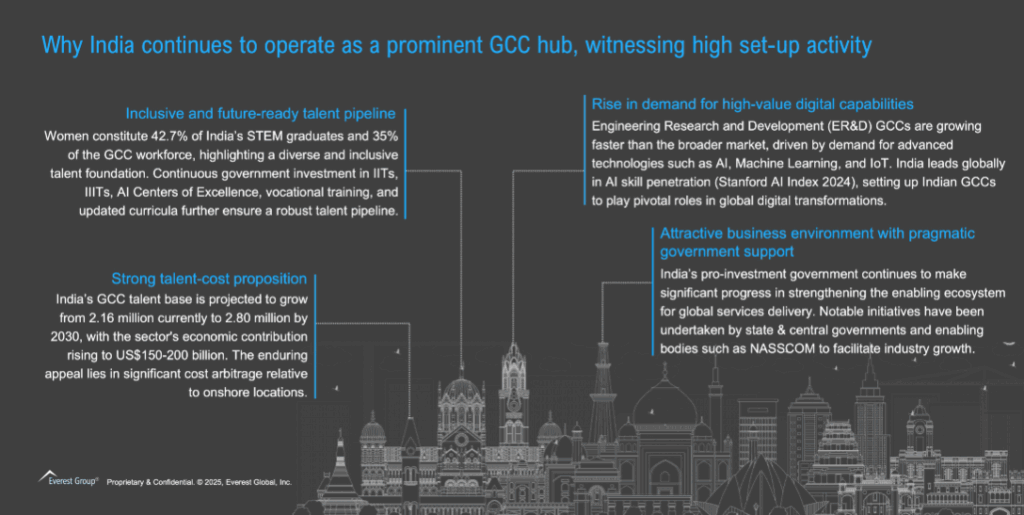India’s Big Bet: Unleashing the GCC Growth Engine

“Half a trillion dollars and 25 million jobs are ours to lose if we do not act,” warned Gunjan Samtani, Chair of the CII Task Force on Global Capability Centers (GCCs) and Country Head of Goldman Sachs Services India, setting the tone for the recent CII GCC Summit held in Delhi on July 14, 2025.
Recognizing this critical juncture, India’s Honorable Finance Minister Nirmala Sitharaman underscored the urgency in her 2025 budget speech, elevating GCCs as strategic engines of innovation and economic resilience, not merely job creators. “In 2024, we added one new GCC every single week,” she highlighted, signaling India’s decisive pivot from cost-saving delivery hubs toward becoming global innovation powerhouses.
Reach out to discuss this topic in depth.
According to Everest Group’s proprietary GCC / Global Business Services (GBS) database, India already hosts over 1,800 GCCs serving more than 1,200 global enterprises, employing approximately 2.1 million professionals and directly contributing around US$68 billion (1.6%) to the nation’s Gross Domestic Product (GDP). Yet, this substantial achievement is merely a fraction of the potential opportunity ahead
To capture the full scale of this opportunity, the CII GCC Business Summit 2025 brought together senior policymakers, state officials, GCC industry leaders, educators, technology providers, and investors. The summit emphasized the imperative of immediate, decisive policy action and investment incentives, driving home the need for ecosystem enablers and robust cross-sector collaboration to sustainably scale India’s GCC operations.
As India now moves boldly from acknowledgment to enablement, the stage is set, this decisive step could redefine India’s future as a global innovation and economic powerhouse for the long term.
Why India remains a top GCC destination

Government’s strategic roadmap for GCC growth
The Indian government has set clear goals to significantly scale the GCC footprint, from 1,800 to 5,000 centers, targeting sectors like defense, semiconductors, and autonomous engineering. This strategic expansion is expected to create 20-25 million jobs, comprising 4-5 million direct, 3.4-4.3 million indirect, and 12.3-15.6 million induced roles. To achieve these ambitions, the government outlined several key initiatives at the GCC Summit:
-
- Accelerated approvals: Introducing a single-window digital portal that reduces GCC incorporation timelines from six months to just 15 days, underscored by Romal Shetty, CEO of Deloitte South Asia, who stated, “Companies should worry about innovation, not paperwork.”
-
- Governance and regulatory clarity: Commitment to translating government support from the Union budget into actionable governance improvements with structured mechanisms at both Union and State levels. Efforts include streamlined advanced pricing rulings and consistent regulatory frameworks to reduce uncertainties for GCC operations.
-
- Enhanced digital and physical infrastructure: Investing ₹1.39 lakh crore in BharatNet to ensure reliable digital access across the country, coupled with the development of integrated Digital Economic Zones designed to support global capability centers, startups, and innovation hubs
-
- Comprehensive talent and skilling initiatives: Launching early skilling initiatives, a national digital “skills passport” for credential verification, and developing dedicated skill hubs, such as the new 20,000 square-foot facility in Aurangabad Industrial City
-
- Securing global leadership in AI: Reinforcing India’s global lead in Artificial Intelligence (AI) skill penetration through strategic investments in AI Centers of Excellence and robust academia-industry collaboration
Expanding inclusiveness beyond metro cities – The way forward
To sustainably achieve CII’s vision of expanding the number of GCCs to 5,000 by 2030, reliance on tier-1 cities alone is not practical. With over 90% of GCCs currently concentrated in six metro areas, there is immense pressure on their physical infrastructure, resources, and talent pools. Thus, it is imperative for India to develop a robust ecosystem, encompassing infrastructure, technology, connectivity, and supportive policies, in tier-2/3 cities.
Cities such as GIFT City, Visakhapatnam, Coimbatore, Jaipur, and Indore present significant potential as future GCC locations. GIFT City stands out as an exemplary model, successfully leveraging strategic regulatory frameworks, advanced infrastructure, and targeted incentives with presence of leading institutions such as Bank of America, Oracle, IBM, Standard Chartered, HSBC, and many more.
Everest Group has consistently supported GCCs and service providers in strategizing diversification toward these emerging locations. Although tier-2/3 cities currently host a higher presence of service providers compared to GCCs, targeted governmental policies and strategic investments are essential to unlock their potential and lay the groundwork for India’s next wave of GCC growth.
Read more: India’s Services Delivery Overview – Tier-1 Hubs Continue to Grow, Tier-2/3 Speeding Up
Closing thought
With strong government backing, proactive policy frameworks, and strategic infrastructure investments, India’s GCC story is positioned for significant growth. More importantly, the ability to anticipate and respond proactively will distinguish transactional setups from strategic ones. GCCs today are no longer just delivery engines; when structured correctly, they become embedded extensions of enterprise innovation, talent, and transformational agendas.
If you found this blog interesting, check out Beyond the Hype: Unpacking the Risks Associated with Global Capability Centers (GCCs) | Blog – Everest Group, which delves deeper into another topic regarding GCCs.
If you are interested in discussing how Everest Group can help you further or to speak about these parameters in more depth, please reach out to us at [email protected] or [email protected]